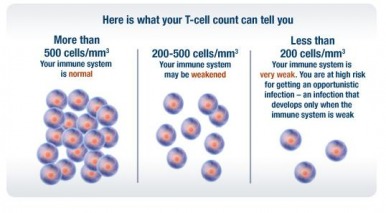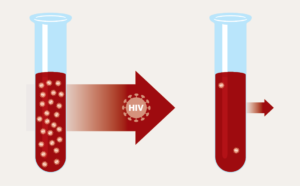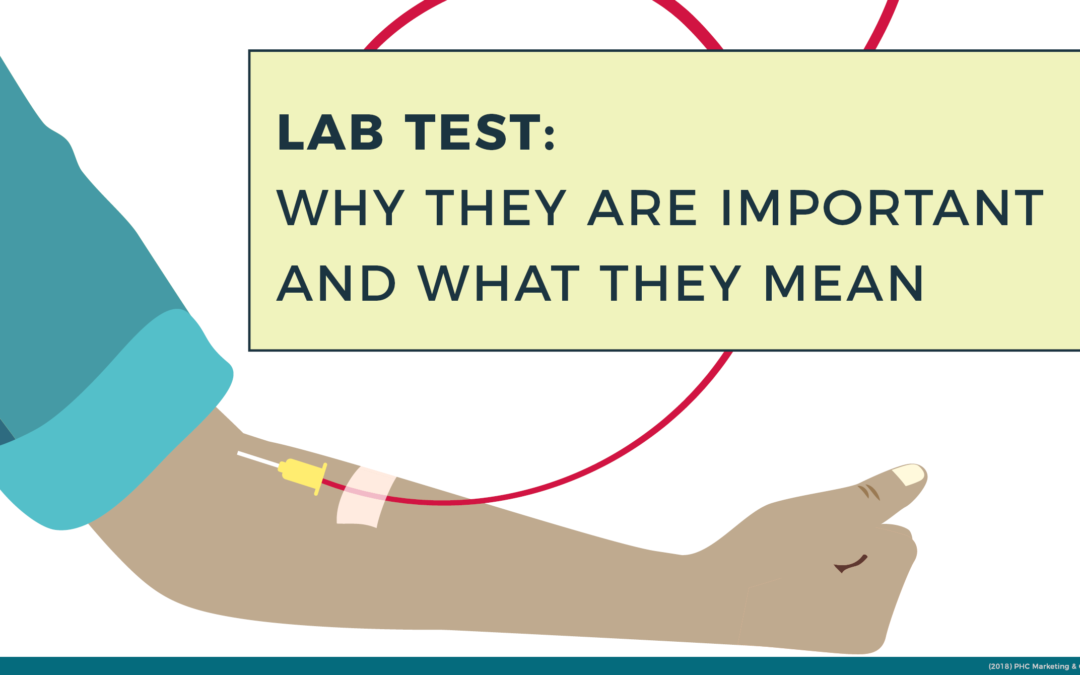Your Lab Tests Help Keep You on Top of Your Health
Showing up for your appointments and getting your lab tests done are good ways to help your healthcare professional fight HIV and keep you healthy.
Your healthcare professional uses these tests to track what HIV is doing in your body over time, as well as how your body is working overall. If something changes in your lab tests, it can be an alert that your treatment may need to change or that there may be something going on that needs attention.
Remember that all lab results have a “reference range,” or a spread of number that are a healthy range. This range may not be the same for everyone: it can vary by age, gender, and ethnicity, and even depends on what testing lab you go to. So it’s important to ask your healthcare professional to explain your results.
Tests That Show How Well Your Immune System and/or Treatment Are Working
CD4+ Cell Count
 This test counts the number of CD4+ cells in your blood, which shows how healthy your immune system is. The CD4+ cell count helps your healthcare professional decide when it’s time for you to start HIV treatment. This test is also used to make sure your treatment is still effective.
This test counts the number of CD4+ cells in your blood, which shows how healthy your immune system is. The CD4+ cell count helps your healthcare professional decide when it’s time for you to start HIV treatment. This test is also used to make sure your treatment is still effective.
Generally, the normal CD4+ count range is between 500-1500 cells/mm3. A CD4+ count that is less than 500 cells/mm3 means your immunes system is weakening and you have an increased risk for infections a healthy person would not typically get. A CD4+ cell count below 200 cells/mm3 is the defination of AIDS, and means the risk for infection is even greater.
Viral Load (VL)
 This test measures the amount of HIV in your blood. This is called your viral load or VL. The viral load test will tell how well treatment is working. Your healthcare professional may need to change your treatment if your viral load gets higher.
This test measures the amount of HIV in your blood. This is called your viral load or VL. The viral load test will tell how well treatment is working. Your healthcare professional may need to change your treatment if your viral load gets higher.
The goal is to get your viral load to undetectable, which means the virus level can’t be counted even though some virus is still there. Because everyone is different and different labs may not use the same test, undetectable can typically range from lee than 20 copies/mL to less than 75 copies/mL. When the viral load becomes detectable, this means that HIV may no longer be under control.
Two important goals of treatment are to:
-
Increase your CD4+ cell count
-
Keep your viral load as low as possible
Tests That Shows Which HIV Medicines to Use
Drug Resistance Test
Sometimes the HIV virus changes and some medicines will not work because this change. This is called resistance. Drug resistance tests can show which HIV medicines will work best against the changed virus. There are 2 types of resistance tests you may take: genotypic and phenotypic. Your healthcare professional will recommend which one is best for you.
Sometimes resistance can happen if you don’t take your medicines all the time according to instructions. If resistance happens you will have to change medicines, and you may have fewer treatment options. This is why it is so important to take your medicines exactly the way your healthcare professional explained to you.
Tests The Show How Healthy Your Body Is
Your healthcare professional may decide you need other tests to make sure your body is working properly or to see if your treatment is affecting your body in ways that may not be good. Below are some of the common lab tests you may take.
Complete Blood Count
This test check the makeup of your blood, such as the res and white blood cells and platelets. If your red blood cells are low, you may have anemia and feel tired. If your white blood cells are high, you may be fighting an infection – or if your white cells are too low, you may be at risk for an infection. Your platelets help your blood to clot and stop bleeding, so your count should not be allowed to get too low.
Chemical Screen
This is a group of blood tests that measure important chemicals to see if your body is working properly. A chemical screen keeps track of how your liver, kidneys, and pancreas are working and also checks your cholesterol. It also can tell if you have a certain other infections or conditions, and if your HIV treatment is causing side effects.
Tuberculosis (TB) Test
People with HIV are at higher risk of getting tuberculosis and it is more dangerous for them than people without HIV. If not treated properly, tuberculosis can be fatal.
Sexually Transmitted Infection (STI) Screening
If you were infected with HIV during unprotected sex, you may have become infected with other diseases, such as gonorrhea, syphilis, and/or chlamydia. These diseases can make HIV more severe. They can also make you 2 to 5 time more likely to pass HIV to a sexual partner.
Hepatitis A, B, and C
Hepatitis B and hepatitis C are more common among people with HIV than hepatitis A. Hepatitis B and hepatitis C can cause long-term illness, life-threatening complications, and death.

